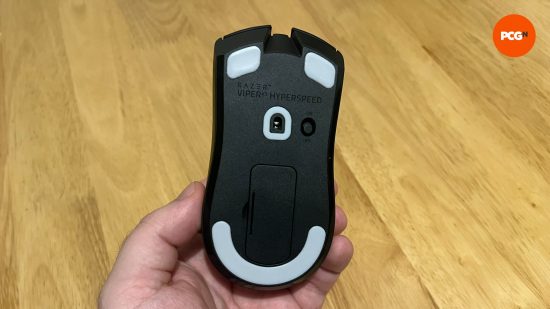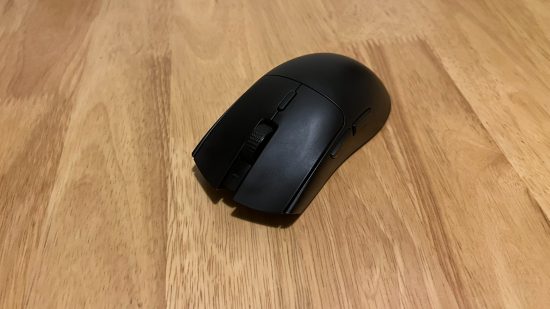So many gaming mice currently ask you to pick just one feature that you really want to be perfected and then offer little attention to everything else. The Razer Viper V3 Hyperspeed is not like other mice. It doesn’t want to just be light, responsive, comfortable, or quick, it wants to give you all of that and much more.
The Razer Viper line of mice has long been regarded among the best gaming mouse options, but the V3 Hyperspeed takes the lineage of this mouse and cranks everything up to eleven. An iconic shell design is pushed to its limits and Razer has no business pushing this much quality into a gaming mouse while still charging well under $100.
Pros
- Ultra responsive
- Long battery life
- Fast polling rate
- Unreal price
- Onboard profile storage
Cons
- Heavy compared to the market trend
| Razer Viper V3 Hyperspeed specs | |
| Sensor | Razer Focus Pro 30k Optical |
| Buttons | 6 |
| DPI | 30,000 Max |
| Weight | 82g |

Razer Viper V3 Hyperspeed features
The box-listed features of a mouse can sometimes be lost on me, as they mean very little until you actually have it in your hands and are using it in your favorite games. Such is the situation here with the Viper V3 Hyperspeed.
Razer’s Focus Pro 30K optical sensor is paired with its mechanical Gen-2 mouse switches, a native polling rate of up to 4000Hz, and a max DPI of up to 30,000. See? It doesn’t mean much without translation into how this will impact your games.
It’s worth noting, however, that the Razer V3 Hyperspeed is capable of up to 8,000Hz polling which was activated recently via a firmware update, but only when used with the Razer Hyperpolling Wireless Dongle, purchased separately for $30, or it can be found bundled with the Viper V3 for a hefty discount, at the time of review.
The onboard memory can be used to store your preferred mouse setup, including your DPI, programmable button use, and lift-off and landing distances. This allows you to use your mouse with any setup without having to install Synapse to set up your profile over and over.
Speaking of the lift-off and landing distances, rather than three pre-set levels to choose from like with their previous mice, you now have access to 26 levels of lift-off and landing distance for true personalization.
Razer Viper V3 Hyperspeed design
As an esports mouse, the Viper V3 Hyperspeed focuses on comfort and grip over unnecessary RGB hotspots. Two major ways that Razer excels here are with a shifted rear hump that allows the V3 to sit more naturally in the center of the palm, and pronounced ridges on the left and right clicks to prevent the possibility of slipping in clutch moments.
These two seemingly minor changes really make a world of difference, especially in a market where everyone is fighting to design a mouse that feels like a natural extension of your hand. I was a fan of the Viper V2, but the V3’s changes are so incredibly game-changing, that it’s easy to notice how much better the V3 is within seconds of holding it.
Beyond these adjustments, the Razer Viper V3’s pads are also improved, and take up very little space on the underside of the mouse. It’s hard to place the material based on feel alone, but it allows the Viper V3 to feel like it’s floating on any surface you use it on, including glass, which now has vastly improved tracking provided the glass is at least 4mm thick.
A DPI button sits nicely below the scroll wheel, which has a satisfying notched feel to it as you spin it, as well as being virtually silent. The DPI placement is a big one as on previous models, it’s been tucked away underneath the mouse, but Razer is finally seeing the light, and puts it where it can be used during gameplay on the fly.

Razer Viper V3 Hyperspeed performance
While the Razer Viper V3 Hyperspeed advertises itself as an esports mouse, don’t be fooled, the performance on show here is perfect for any game. Shooters are naturally where you’ll benefit the most from the rapid click responses and polling rate, but responsiveness is a major benefit across all genres. The jury is still out on how much effect a polling rate really has going from 1,000Hz to 8,000Hz, especially on monitors with lower refresh rates. However, I can say there was a more noticeable difference between 1K and 4K than 4K to 8K, but perhaps not enough of a difference for me to suddenly declare 1,000Hz mice dead, yet.
The harsh fact remains that 8,000Hz polling is a draw on your CPU and could have an impact on your fps, if your resources are limited. For now, it’s a ‘nice to have’ rather than a necessity, but future-proofing yourself is always a smart way to operate. It may one day become the standard, but for now, it’s not a feature that’s going to have a major impact on your performance.
Using anything above 1,000Hz also seriously reduces the battery life of the Viper V3 Hyperspeed. This is where the design choice of an AA battery power source pays dividends and prevents it being an issue. Rather than draining a built-in battery, which would have been considerably lighter, but required constant charging, the AA option allows for quick swapping to allow you to return to your game faster than ever, and without more wires sprawling across your desk.
As for the battery life, you can get 230 hours out of a single AA battery on the standard 1,000Hz polling rate, this scales down to around 50 hours on the highest rate, which is still competitive with some rechargeable mice – as set of charge-holding rechargeable batteries, such as Panasonic’s Eneloop range would be a wise investment. Razer Synapse also contains various power-saving options to ensure you’re never losing juice while idle.
Razer’s Focus Pro Optical sensor is also a game-changer for how it tracks the surface you’re using and the motions you’re making while gaming. No mouse sits flush with the surface you’re using, so the Focus Pro sensor is always calculating the distance and is ready for any potential changes to ensure you always have the same level of control and accuracy. Regardless of the size or material of your surface, the Razer Viper V3 won’t let you down.
Likewise, with motion sync, rather than haphazardly plotting points along a path to track the Viper’s movement, it’s a 1:1 system that means every movement you make is replicated with complete accuracy. It makes for a much smoother feel to moving your cursor around a screen, and results in fewer moments of janky movement when gaming. However, it also means there’s no blaming your missed shots on the Viper: that’s a skill issue.

Should you buy the Razer Viper V3 Hyperspeed?
Yes. Without hesitation, I can strongly suggest the Razer Viper V3 Hyperspeed as your next gaming mouse. All of the above features and performance should easily cost you north of $100, but at $69.99 / £69.99, the Viper V3 is just insane value.
There is no alternative I can currently think of that would match the level of the Viper V3 while also bringing this many features to the table. If you absolutely need your gaming mouse to be ultra-light, I would suggest the Corsair M75 Air, but it actually falls short in the max polling rate and battery life when compared to the Viper, and is more than twice the price.
Verdict
The Razer Viper V3 Hyperspeed is the best wireless gaming mouse you’ll find for under $100. Rapid response times, an amazing level of comfort, long battery life, and practical design tie together nicely to become the ideal clicker for any game you play.
Our Verdict
A stunning mouse in every aspect, from its clean cut design through to the in-game performance, there are few mice like the Viper V3 Hyperspeed but Razer have made quite the statement to the market with this release.
